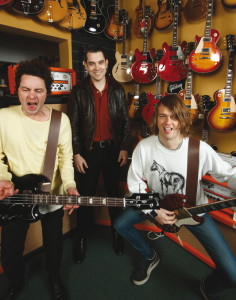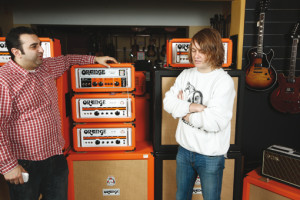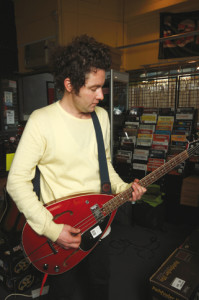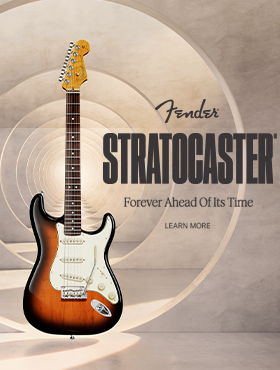September 2010. By Reza Nasseri and Greg Phillips. Photos by Marty Williams
 They first punched us square in the face in 2008 with their contagious, fuzz-laden debut album ‘The Long Now’. Lately Melbourne’s three-piece rockers, Children Collide have been bombarding the airwaves with ‘Jelly Legs’, the first single from their brand new album ‘Theory of Everything’. These guys have a long history of instrument abuse, broken headstocks, bloodied guitars, destroyed reverb tanks, and as we discovered recently, compensating for stolen gear by using guitar pedals found in a club’s kitchen. Reza Nasseri and Greg phillips had the pleasure of spending a few hours with the band by talking shop at various instrument stores around Melbourne.
They first punched us square in the face in 2008 with their contagious, fuzz-laden debut album ‘The Long Now’. Lately Melbourne’s three-piece rockers, Children Collide have been bombarding the airwaves with ‘Jelly Legs’, the first single from their brand new album ‘Theory of Everything’. These guys have a long history of instrument abuse, broken headstocks, bloodied guitars, destroyed reverb tanks, and as we discovered recently, compensating for stolen gear by using guitar pedals found in a club’s kitchen. Reza Nasseri and Greg phillips had the pleasure of spending a few hours with the band by talking shop at various instrument stores around Melbourne.
The first port of call was a store in Brunswick St, Fitzroy, where our crew met up with singer/ guitarist Johnny Mackay. Johnny was first on the scene with a packed suitcase ready to head north to Splendour in the Grass the moment his Australian Musician duties were completed.
Johnny Mackay (guitar and vocals): (whilst surrounded by a wall of Orange Amps) I love running a Sans Amp into these Orange amps. The sound is just so thick. Originally I was looking at getting a Rockerverb 50, but the only issue I had was that it kept “breaking up” too early. It didn’t have enough clean headroom for me.
Reza Nasseri (Australian Musician): Well they’re basically a vintage amp, and tend to break up a lot earlier than modern designs. But they compress beautifully at low volumes.
JM: But because I use pedals for everything, I need a really clean tone.
RN: So your major source of drive comes from pedals?
JM: Totally. I don’t use amp drive at all.
RN: It also sounds like you’re using a lot of fuzz on the new album. Were you using a Big Muff?
 JM: I was, but I got rid of that. At the moment I’m using a Line 6 Pocket Pod, for my heaviest distortion, and using a Sans Amp for my less heavy distortion. It’s like a Tame Impala interview I saw on…. I think it was Channel V, where the host keeps saying “It sounds really analogue”, and they keep saying “But it’s digital” (laughs).
JM: I was, but I got rid of that. At the moment I’m using a Line 6 Pocket Pod, for my heaviest distortion, and using a Sans Amp for my less heavy distortion. It’s like a Tame Impala interview I saw on…. I think it was Channel V, where the host keeps saying “It sounds really analogue”, and they keep saying “But it’s digital” (laughs).
At this point in time we are now joined by bassist Heath Crawley and drummer Ryan Caesar and the band gathers round some gear for photos. Heath has eyed off and grabbed a Black Gibson SG bass off the wall, while Johnny plays some tasty licks on a beautiful vintage SG re-issue …
Greg Phillips (Australian Musician): What’s your main bass at the moment?
Heath Crawley (bass): It’s a ’83 Westone bass, which is like a cheap Japanese thing from the early 80s. I don’t know if they’re still making instruments. It’s got a late 70s Ibanez pickup in it and is basically a “Frankenstein” that I love. I just got another one recently that I need to smash up a little bit. It’s a white version of my main bass and I want put all the original dials back on it and get it up to scratch to play at gigs.
With the clock ticking for Johnny to get to his plane, we all decide to make a quick trip up the road, taking in the caffeinated aroma of Brunswick Street to spend a bit of time at Fretted Instruments to see what else we can play with. Greg Phillips continues chatting to Heath on the way there…
GP: Are you into effects at all?
HC: I don’t use any effects in Children Collide which makes things kind of interesting. It’s kind of a duel onstage, as Johnny has got all kinds of effects going on, a thousand pedals on his board (laughs). I play my bass as if it were almost not a bass, but like a baton, with very minimal sustain and a raw sound. I get quite a bit of gain dialled through the amp, so that’s where my effect is. I can then manipulate the sound by how hard I hit the bass, and sometimes I get a bit of discord happening by hitting the string too hard.
GP: You and Ryan really lock in well together, and I suppose that allows Johnny to paint over that with his sound.
HC: That’s right. I’m just adding a melodic element to the drums, and I like how that works in Children Collide. It’s what makes us sound unique as a band too.
Second destination: We all arrive at Fretted Instruments and are greeted by the amiable staff. Greg continues chatting to Heath about his bass, while Reza and Johnny continue to talking about guitars. Meanwhile, Ryan sits patiently in the corner waiting for his turn.
RN: I’m guessing by a lot of the sounds I’ve heard on the album and the live footage I’ve seen, you tend to gravitate towards using Fender Mustangs and Jaguars?
JM: Yeah I’m usually using a Jag, but I am going to try and start using these two new guitars I’ve recently bought. I recently bought a Teisco Spectrum 5 (legendary instrument made in 1966, in Japan). I don’t know if you’ve ever seen one of those, but they’re one of the best looking guitars I’ve seen in my life. I’m just trying to make it sound as good as it looks. I also just got a 1965 Gibson Firebird 3, with the non-reverse headstock, and both those guitars are getting set up at the moment.
RN: What is it specifically that attracts you to that sort of guitar?
 JM: I dunno, when the band first started I went out and got a loan and bought that guitar and got used to it. I owned really shit guitars before that, except for a Maton ’64 Firebird, but I absolutely trashed that guitar and it was completely f***ed by the time Children Collide started (laughs). I also had another crappy, old, homemade guitar with pictures of naked girls and motorbikes on it, and I wish I hadn’t sanded it and repainted it when I bought it. The previous owner had just cut the pictures out of magazines, and lacquered over the top. It was hilarious and I really regret changing it.
JM: I dunno, when the band first started I went out and got a loan and bought that guitar and got used to it. I owned really shit guitars before that, except for a Maton ’64 Firebird, but I absolutely trashed that guitar and it was completely f***ed by the time Children Collide started (laughs). I also had another crappy, old, homemade guitar with pictures of naked girls and motorbikes on it, and I wish I hadn’t sanded it and repainted it when I bought it. The previous owner had just cut the pictures out of magazines, and lacquered over the top. It was hilarious and I really regret changing it.
Johnny walks over and picks up a candy-apple red Fender Jaguar off the wall.
JM: I can probably plug this into something, and these are the type of pickups I use on my Jaguar as well, just the two single coils, except I replaced the original pickups with 2 Seymour Duncan “Hot for Jags”, and put them in my Mustang too. I also get all the switches filed down on my guitars to stop me from bumping them and accidentally changing settings when I play live because I tend to throw guitars around a lot on stage.
RN: So what have you got in your live rig at the moment?
JM: For the past couple of years I’ve been touring with my 80’s Jap Jag and this Mustang over here.
Johnny pulls out his own red Fender Mustang out of a beaten up case, which has all the knobs and switches gaffa-taped down, and traces of dried up blood smeared on the scratch plate.
It’s a ’72 American Mustang which has been changed to be left handed at some point then changed back. We played a media launch for our first album and after I pulled it out of its case the next day, half of the headstock was completely missing. I don’t know how my tech missed that, so I brought it in here and these guys fixed it for me.
RN: Earlier you mentioned you used a clean amp with a lot of headroom in your rig. What are you using at the moment?
JM: I’ve had a Marshall JCM 900 forever, but it’s breaks down. You really need to get a well maintained one. When they’re well maintained they sound amazing. I arrived at a festival once with thousands of people in front of me, plugged in, turned the amp up to 8 and could hardly hear anything coming out of it. I was like, great … something’s blown inside it. I had to play the whole festival with that shitty amp which was not a lot of fun but I guess that’s the danger with hiring any gear.
RN: You’ve also recently been using the Line 6 POD’s again?
JM: I used to have a Version 2 POD with a little footswitch that went straight into the front of my amp, but that got stolen in Brisbane. I used to run a Boss Pitchshifter Delay (PS-3) behind that as well.
RN: So you’d go from the guitar to the POD to the amp?
JM: Yes, always. I never use the effects loop in my amp, I don’t know why (laughs).
RN: Actually a lot of players prefer running their pedals in front because they like how the preamp colours the tone.
JM: I’ve never been the type of guitarist to spend hours searching for the perfect tone, but I know what I like, and because I’d had the POD for so long I had it worked out really well. I had it sounding amazing, and every engineer would screw up their nose when they’d see me using it. But it got stolen in Brisbane at the Zoo which was such a bummer, and I had to play a show the next night, a sold-out show at Metro in Sydney supporting a band. We scrambled around and found some pedals in the kitchen of the Metro and ended up using them that same night. I had to balance on my heels in order to switch two at once for some parts of songs which was horrible. Only recently I bought that Pocket POD, but it tends to sound better in some amps than others, because it breaks up quite easily. I’m really looking forward to using it with this Clip amp live, because it sounded amazing in the studio.
RN: So do you use the POD for your reverb and delay sounds?
JM: No I only use it for one heavy sound. I go from my guitar into my tuner pedal, into the Carl Martin Octa Switch, then I run a Boss PS-2 after that which I only use for delay, an Akai Headrush which I use for delay and sometimes looping which I do between songs. I like to make a noise loop after a song, so I can tune my guitar, and even though we have a tech, it’s something I like to do myself. I run my POD into the Carl Martin for a thick, massive drive and a Sans Amp for a more ‘Garagey’ distortion. Then I use a Holy Stain (Electro Harmonix) for reverb and a bit of Tremolo, a Memory Man (EH) for another delay and a Boss EQ pedal to thin out the sound as an effect.
Johnny grabs his Fender off the wall and plugs into a little Fender Deluxe.
JM: I’m thinking of getting one of these (Fender Deluxe) for the other band I play in, because I’m sick of carting a Marshall stack around to rehearsal. I need something smaller for that band. They’re a nice thick, loud sounding amp that can make thin guitars sound big. I’m thinking about putting a deposit on this one.
While Johnny plays through the Deluxe, Heath has been walking around the room playing a hollow body Elite ’64 bass and has walked a bit too close the door and set off the security alarm. Johnny laughs loudly.
Heath then plugs into a 100w Crate combo.
HC: I can already tell this bass is going to sound honky and is low on sustain which are two things I really like.
RN: What sort of amps do you like to plug into?
 HC: Generally Ampeg’s, SVT 2’s, the SVT 3 Pro, and whenever possible one of the old Classic heads. The big fat SVT’s are perfect, they’re great. I love ‘em. I crank heaps of mids out of them and go from there.
HC: Generally Ampeg’s, SVT 2’s, the SVT 3 Pro, and whenever possible one of the old Classic heads. The big fat SVT’s are perfect, they’re great. I love ‘em. I crank heaps of mids out of them and go from there.
Time for Johnny to leave for the airport and Heath says his goodbyes too. We now make our way down to Revolver Drums in Prahran to chat with Ryan about some of the drum sounds on Theory of Everything.
Reza: I understand you used an old Gretsch kit on the album?
Ryan Caesar (drums): I did use an old Gretsch kit a little in the States, but mainly another Pearl kit. I used my Pearl Masters kit in Melbourne, so we tracked drums on 3 different kits, in 2 different cities, in 2 different countries.
RN: It almost sounds like you used one kit for the whole album, as a lot of the drums sounds seem quite similar between tracks.
RC: Well we tried to get some continuity happening between tracks. When I got home from the US, I tuned my kit myself to try and get the same sound we had in L.A. I actually liked the drum sounds we got in Melbourne more than the tone we got in the States.
RN: The drum sounds on “Theory” are also very natural and don’t sound overly processed. It sounds like they were recorded in a small to medium sized drum room.
RC: I went through a big phase of getting really natural drums sounds and loved a big ‘roomy’ tone. Both studios had fairly medium sized drum rooms. There were a lot of room mics, and spot mics used with very limited use of reverb if any. There were mikes placed down hallways and corridors which all worked in achieving the sound I was after.
RN: The kick drum is also very big and boomy, with a lot of decay and spill happening through multiple mikes.
RC: That’s more of a live thing that we tried to bring to the record. You really feel that kick in your chest.
RN: I know you’re endorsed by Pearl and Zildjian. Is there a particular drum or cymbal which is an essential part of your kit?
RC: That’d have to be the Zildjian Sweet Ride, because I’ve used heavier rides in the past that weren’t as diverse in the amount of tones you can get out of them. Being in a 3 piece band requires you need to cover a lot of ground with your drum tones, and I can go from a soft ping to a really massive wash, so it’s almost like having a big crash as well.
Theory of Everything is out now. The band is touring nationally through September, 2010. www.childrencollide.com


